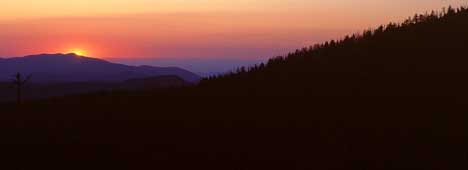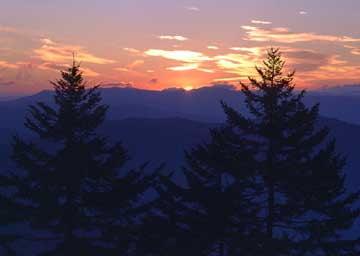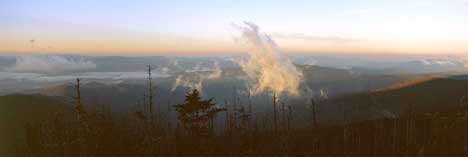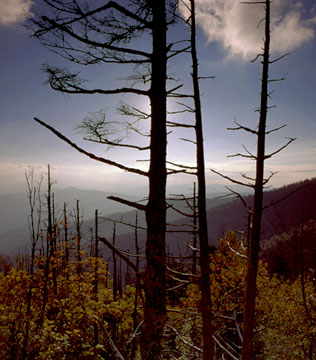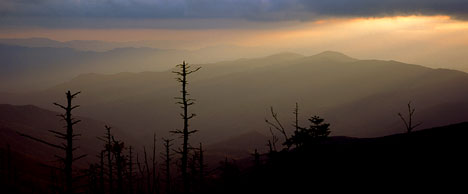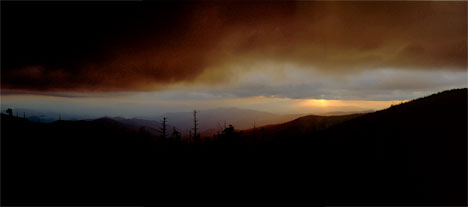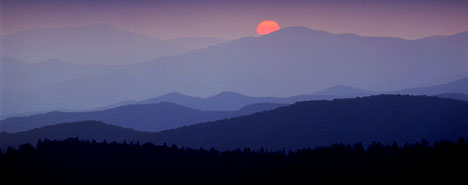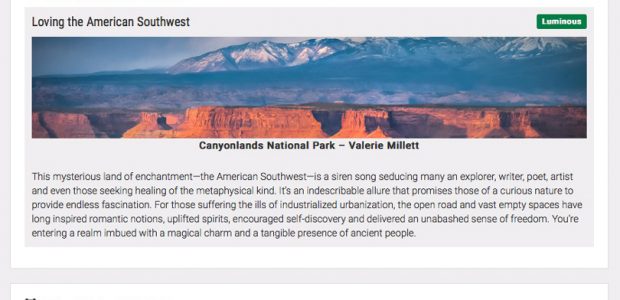Clingmans Domeis the highest point inGreat Smokyand is located about a half hour drive from the town ofCherokee. There is an observation platform about a half hour’s hike up from the parking lot but it’s possible to get great sunset shots right from where you park. The view to the east is obstructed, so for sunrise the turn-out partway up the 7 mile road fromNewfound Gapis the best spot at that time of day.
Clingmans Dome Road Sunrise #1. Great Smoky Mountains NP. September, 2000
Photographed with a Hasselblad XPan and 90mm lens on Provia 100F.
On my first visit, though it was still the first half of September an Arctic high pressure area had descended and the 80 degrees F weather that we’d had in Atlanta earlier that day had become 40F with a 40 MPH wind blowing. It was cold!
Clingmans Dome Road Sunrise #2. Great Smoky Mountains NP. September, 2000
Photographed with a Hasselblad XPan and 30mm lens on Provia 100F.
The next morning it was even colder. This photograph was taken about 20 minutes prior to dawn at the turn-out about half-way up the road fromNewfound Gap, the mid-point of the road that cross the park.
Clingmans Dome Road Sunrise #3. Great Smoky Mountains NP. September, 2000
Photographed with a Rollei 6008 and 180mm Schneider lens on Provia 100F.
The photograph above was taken just minutes later but with a much longer focal length lens. It’s instructive to compare them. (These are the small trees in the center of the frame above this one).
Clingmans Dome Sunrise #3. Great Smoky Mountains NP. September, 2000
Photographed with a Hasselblad XPan and 45mm lens on Provia 100F.
Once the sun had risen we continued to the top of the mountain. The dramatic weather conditions had created fast-moving clouds that billowed upwards from the valley catching the pink light of dawn. While the first image offers dramatic saturated light, this ones counterpoint is its softness and delicacy.
Interestingly, this frame and the XPan image previously above are right next to one another on the roll; the last shot taken at one location and the first one at the next. This isreallyunusual.
I returned toGreat SmokyandClingmans Domefor the second time on the last weekend of September. The weather conditions were wonderful, clear and mild with strong atmospherics at either end of each day.
What I find fascinating about these next four photographs is that they were all shot from the same spot over a period of just 2 hours.
Clingmans Dome Forest. Great Smoky Mountains NP. September, 2000
Photographed with a Hasselblad ArcBody and 45mm Rodenstock lens on Provia 100F.
Regrettably, many of the trees at the peak ofClingmans Domehave been devastated by a blight, though this has created some dramatic photographic opportunities.
This photograph, taken about 90 minutes before sunset, presented several challenges. The primary one was the huge contrast difference between the foreground and the sky. The use of two split neutral density filters totaling 5 stops of ND applied to the top half of the frame helped bring the brightness to within the capabilities of the film. About 10mm of front rise also helped keep the trees properly vertical.
Clingmans Dome Sunset #1. Great Smoky Mountains NP. September, 2000
Photographed with a Hasselblad XPan and 90mm lens on Provia 100F.
Cloud movement on this particular evening were very rapid. This photograph was taken not more than 15 minutes before the one below.
Clingmans Dome Sunset #2. Great Smoky Mountains NP. September, 2000
Photographed with a Noblex 150UX on Provia 100F.
There is much detail in this transparency that simply can’t be captured by theEpson 1200Uscanner that I am using temporarily while on the road. Once I’m able to rescan with myImacon FlexTight Photoscanner in November the richness of this image will become apparent. It’s included for now to show the rapid transition that took place in the sky, and the variations that are possible with differing equipment over a short period of time.
Clingmans Dome Sun. Great Smoky Mountains NP. September, 2000
Photographed with a Rollei 6008 and 300mm Schneider lens on Provia 100F.
I almost didn¹t get this one! After some 90 minutes of shooting at the summit, and as can be seen from the three frames above, having captured several successful images, a heavy cloud bank moved in to obscure the sun and a pall of flat gray light descended.
Two other photographers had been shooting beside me; a tourist from Britain, with whom I had a pleasant chat as we did our photography, and a Japanese tourist who kept to himself.
With the fading light my British colleague called it quits and drove off. Though I always preach that one should stay till the biter end, since experience has provided me with a number of last-minute surprises at sunset, it was becoming so gloomy that I too called it a night, returned to my car and started to pack-up my gear.
With my camera bags zipped shut I was just about to close my trunk lid and begin the one hour drive back to my motel inMaggie Valleywhen the Japanese tourist approached me insistently saying,‚³The sun, the sun². At first I didn¹t understand but then I turned around and there was an orange ball emerging from the cloudbank and sinking rapidly toward the mountains just a few degrees below it.
As quickly as I could I unpacked my Rollei 6008 with 300mm lens and tripod and ran back to the edge of the lookout. Doing a quick spot reading of the mid-level mountains I managed to shoot off 6 frames before the roll was exhausted and the sun disappeared. Naturally I thanked my benefactor profusely before heading off. I must have had an embarrassed grin on my face the whole way back to town.
I¹d like to add that though this image looks unreal, more like a lithograph than a photograph, it is as close to the original transparency as I can make it, with no digital shenanigans whatsoever.Price Waterhouseauditors are standing by to verify this to any doubters in the audience 🙂
An Equipment Note:
As you likely have read elsewhere in this section, because I was living away from home, in Atlanta, for almost 2 months, I was able to carry more equipment in my car than I normally would on a shoot that I would fly to. Most times I concentrate on working with just one tool at a time.
But on this occasion all four cameras came into play during a short period of time. TheArcBodyfor the tree study where movements were needed, the tight panoramic with theXPanand 90mm, and theNoblexfor the ultra- wide view of the overall scene.
Finally, theRolleiwith a medium-long lens allowed me to capture the compressed layers of the mountains and setting sun, though the subject matter necessitated that I crop the image to a wide-format presentation, turning it to into a panoramic.
You May Also Enjoy...
What’s New Is What’s New
About one year ago, we began the project of converting Luminous-Landscape to the new and present format. It was a difficult task since there were
